FTL液位音叉开关
- 格式:pdf
- 大小:239.03 KB
- 文档页数:8
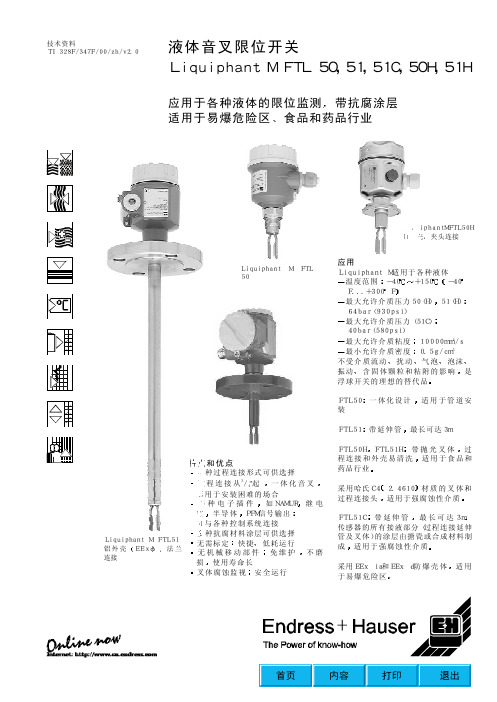
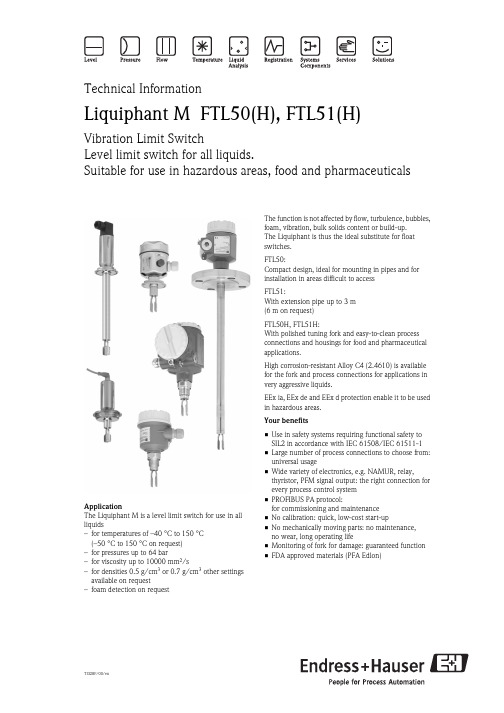
TI328F/00/enTechnical InformationLiquiphant M FTL50(H), FTL51(H)Vibration Limit SwitchLevel limit switch for all liquids.Suitable for use in hazardous areas, food and pharmaceuticalsApplicationThe Liquiphant M is a level limit switch for use in all liquids–for temperatures of –40 °C to 150 °C (–50 °C to 150 °C on request)–for pressures up to 64 bar–for viscosity up to 10000 mm 2/s–for densities 0.5 g/cm 3 or 0.7 g/cm 3 other settings available on request–foam detection on requestThe function is not affected by flow, turbulence, bubbles, foam, vibration, bulk solids content or build-up. The Liquiphant is thus the ideal substitute for float switches.FTL50:Compact design, ideal for mounting in pipes and for installation in areas difficult to access FTL51:With extension pipe up to 3 m (6 m on request)FTL50H, FTL51H:With polished tuning fork and easy-to-clean process connections and housings for food and pharmaceutical applications.High corrosion-resistant Alloy C4 (2.4610) is available for the fork and process connections for applications in very aggressive liquids.EEx ia, EEx de and EEx d protection enable it to be used in hazardous areas.Your benefits•Use in safety systems requiring functional safety to SIL2 in accordance with IEC 61508/IEC 61511-1•Large number of process connections to choose from: universal usage•Wide variety of electronics, e.g. NAMUR, relay,thyristor, PFM signal output: the right connection for every process control system •PROFIBUS PA protocol:for commissioning and maintenance •No calibration: quick, low-cost start-up•No mechanically moving parts: no maintenance, no wear, long operating life•Monitoring of fork for damage: guaranteed function •FDA approved materials (PFA Edlon)Liquiphant M FTL50(H), FTL51(H)2Endress+HauserTable of contentsApplication . . . . . . . . . . . . . . . . . . . . . . . . . . . . . . . . .4Level limit detection . . . . . . . . . . . . . . . . . . . . . . . . . . . . . . . . . . . 4Function and system design. . . . . . . . . . . . . . . . . . . . .4Measuring principle . . . . . . . . . . . . . . . . . . . . . . . . . . . . . . . . . . . 4Modularity . . . . . . . . . . . . . . . . . . . . . . . . . . . . . . . . . . . . . . . . . . 4Electronic versions for level limit switches . . . . . . . . . . . . . . . . . . 5Electronic versions for level sensor . . . . . . . . . . . . . . . . . . . . . . . . 5Galvanic isolation . . . . . . . . . . . . . . . . . . . . . . . . . . . . . . . . . . . . . 5Design . . . . . . . . . . . . . . . . . . . . . . . . . . . . . . . . . . . . . . . . . . . . . 5Input . . . . . . . . . . . . . . . . . . . . . . . . . . . . . . . . . . . . . .5Measured variable . . . . . . . . . . . . . . . . . . . . . . . . . . . . . . . . . . . . 5Measuring range (detection range) . . . . . . . . . . . . . . . . . . . . . . . . 5Product density . . . . . . . . . . . . . . . . . . . . . . . . . . . . . . . . . . . . . . 5Electronic insert AC, FEL51 . . . . . . . . . . . . . . . . . . . .6Electrical connection . . . . . . . . . . . . . . . . . . . . . . . . . . . . . . . . . . 6Output signal . . . . . . . . . . . . . . . . . . . . . . . . . . . . . . . . . . . . . . . . 6Signal on alarm . . . . . . . . . . . . . . . . . . . . . . . . . . . . . . . . . . . . . . 6Connectable load . . . . . . . . . . . . . . . . . . . . . . . . . . . . . . . . . . . . . 6Electronics AC, FEL51 in compact housing . . . . . . . . .7Electrical connection . . . . . . . . . . . . . . . . . . . . . . . . . . . . . . . . . . 7Output signal . . . . . . . . . . . . . . . . . . . . . . . . . . . . . . . . . . . . . . . . 7Signal on alarm . . . . . . . . . . . . . . . . . . . . . . . . . . . . . . . . . . . . . . 7Connectable load . . . . . . . . . . . . . . . . . . . . . . . . . . . . . . . . . . . . . 7Electronic insert DC PNP, FEL52. . . . . . . . . . . . . . . . .8Electrical connection . . . . . . . . . . . . . . . . . . . . . . . . . . . . . . . . . . 8Output signal . . . . . . . . . . . . . . . . . . . . . . . . . . . . . . . . . . . . . . . . 8Signal on alarm . . . . . . . . . . . . . . . . . . . . . . . . . . . . . . . . . . . . . . 8Connectable load . . . . . . . . . . . . . . . . . . . . . . . . . . . . . . . . . . . . . 8Power supply . . . . . . . . . . . . . . . . . . . . . . . . . . . . . . . . . . . . . . . . 8Electronics DC PNP, FEL52 in compact housing . . . . .9Electrical connection . . . . . . . . . . . . . . . . . . . . . . . . . . . . . . . . . . 9Output signal . . . . . . . . . . . . . . . . . . . . . . . . . . . . . . . . . . . . . . . 9Signal on alarm . . . . . . . . . . . . . . . . . . . . . . . . . . . . . . . . . . . . . 10Connectable load . . . . . . . . . . . . . . . . . . . . . . . . . . . . . . . . . . . . 10Power supply . . . . . . . . . . . . . . . . . . . . . . . . . . . . . . . . . . . . . . . 10Electronic insert AC/DC with relay output,FEL54 . . . . . . . . . . . . . . . . . . . . . . . . . . . . . . . . . . . .11Electrical connection . . . . . . . . . . . . . . . . . . . . . . . . . . . . . . . . . 11Output signal . . . . . . . . . . . . . . . . . . . . . . . . . . . . . . . . . . . . . . . 11Signal on alarm . . . . . . . . . . . . . . . . . . . . . . . . . . . . . . . . . . . . . 11Connectable load . . . . . . . . . . . . . . . . . . . . . . . . . . . . . . . . . . . . 11Power supply . . . . . . . . . . . . . . . . . . . . . . . . . . . . . . . . . . . . . . . 11Electronic insert 8/16 mA, FEL55. . . . . . . . . . . . . . .12Electrical connection . . . . . . . . . . . . . . . . . . . . . . . . . . . . . . . . . 12Output signal . . . . . . . . . . . . . . . . . . . . . . . . . . . . . . . . . . . . . . . 12Signal on alarm . . . . . . . . . . . . . . . . . . . . . . . . . . . . . . . . . . . . . 12Connectable load . . . . . . . . . . . . . . . . . . . . . . . . . . . . . . . . . . . . 12Electronic insert NAMUR L-H edge, FEL56. . . . . . . .13Electrical connection . . . . . . . . . . . . . . . . . . . . . . . . . . . . . . . . . 13Output signal . . . . . . . . . . . . . . . . . . . . . . . . . . . . . . . . . . . . . . . 13Signal on alarm . . . . . . . . . . . . . . . . . . . . . . . . . . . . . . . . . . . . . 13Connectable load . . . . . . . . . . . . . . . . . . . . . . . . . . . . . . . . . . . . 13Electronic insert NAMUR H-L edge, FEL58. . . . . . . .14Electrical connection . . . . . . . . . . . . . . . . . . . . . . . . . . . . . . . . . 14Output signal . . . . . . . . . . . . . . . . . . . . . . . . . . . . . . . . . . . . . . . 14Signal on alarm . . . . . . . . . . . . . . . . . . . . . . . . . . . . . . . . . . . . . 14Connectable load . . . . . . . . . . . . . . . . . . . . . . . . . . . . . . . . . . . . 14Electronics NAMUR H-L edge, FEL58in compact housing . . . . . . . . . . . . . . . . . . . . . . . . . .15Electrical connection . . . . . . . . . . . . . . . . . . . . . . . . . . . . . . . . . 15Output signal . . . . . . . . . . . . . . . . . . . . . . . . . . . . . . . . . . . . . . . 15Signal on alarm . . . . . . . . . . . . . . . . . . . . . . . . . . . . . . . . . . . . . 15Connectable load . . . . . . . . . . . . . . . . . . . . . . . . . . . . . . . . . . . . 15Electronic insert PFM, FEL57 . . . . . . . . . . . . . . . . . .16Electrical connection . . . . . . . . . . . . . . . . . . . . . . . . . . . . . . . . . 16Output signal . . . . . . . . . . . . . . . . . . . . . . . . . . . . . . . . . . . . . . . 17Signal on alarm . . . . . . . . . . . . . . . . . . . . . . . . . . . . . . . . . . . . . 17Connectable load . . . . . . . . . . . . . . . . . . . . . . . . . . . . . . . . . . . . 17Electronic insert PROFIBUS PA, FEL50A. . . . . . . . . .18Electrical connection . . . . . . . . . . . . . . . . . . . . . . . . . . . . . . . . . 18Output signal . . . . . . . . . . . . . . . . . . . . . . . . . . . . . . . . . . . . . . . 19Signal on alarm . . . . . . . . . . . . . . . . . . . . . . . . . . . . . . . . . . . . . 19Connection and function . . . . . . . . . . . . . . . . . . . . . .20Connecting cables . . . . . . . . . . . . . . . . . . . . . . . . . . . . . . . . . . . 20Fail-safe mode . . . . . . . . . . . . . . . . . . . . . . . . . . . . . . . . . . . . . . 20Switching time . . . . . . . . . . . . . . . . . . . . . . . . . . . . . . . . . . . . . . 20Switch-on behaviour . . . . . . . . . . . . . . . . . . . . . . . . . . . . . . . . . 20Performance characteristics. . . . . . . . . . . . . . . . . . . .20Reference operating conditions . . . . . . . . . . . . . . . . . . . . . . . . . . 20Maximum measured error . . . . . . . . . . . . . . . . . . . . . . . . . . . . . 20Repeatability . . . . . . . . . . . . . . . . . . . . . . . . . . . . . . . . . . . . . . . 20Hysteresis . . . . . . . . . . . . . . . . . . . . . . . . . . . . . . . . . . . . . . . . . 20Influence of medium temperature . . . . . . . . . . . . . . . . . . . . . . . 20Influence of product density . . . . . . . . . . . . . . . . . . . . . . . . . . . . 20Influence of medium pressure . . . . . . . . . . . . . . . . . . . . . . . . . . 20Operating conditions. . . . . . . . . . . . . . . . . . . . . . . . .21Installation. . . . . . . . . . . . . . . . . . . . . . . . . . . . . . . . .21Installation instructions . . . . . . . . . . . . . . . . . . . . . . . . . . . . . . . 21Examples of mounting . . . . . . . . . . . . . . . . . . . . . . . . . . . . . . . . 21Orientation . . . . . . . . . . . . . . . . . . . . . . . . . . . . . . . . . . . . . . . . 23Environment . . . . . . . . . . . . . . . . . . . . . . . . . . . . . . .23Ambient temperature range . . . . . . . . . . . . . . . . . . . . . . . . . . . . 23Ambient temperature limits . . . . . . . . . . . . . . . . . . . . . . . . . . . . 23Liquiphant M FTL50(H), FTL51(H) Storage temperature . . . . . . . . . . . . . . . . . . . . . . . . . . . . . . . . . . 24Climate class . . . . . . . . . . . . . . . . . . . . . . . . . . . . . . . . . . . . . . . 24Degree of protection . . . . . . . . . . . . . . . . . . . . . . . . . . . . . . . . . 24Vibration resistance . . . . . . . . . . . . . . . . . . . . . . . . . . . . . . . . . . 24Electromagnetic compatibility . . . . . . . . . . . . . . . . . . . . . . . . . . 24Medium conditions . . . . . . . . . . . . . . . . . . . . . . . . . . 24Medium temperature range . . . . . . . . . . . . . . . . . . . . . . . . . . . . 24Thermal shock . . . . . . . . . . . . . . . . . . . . . . . . . . . . . . . . . . . . . . 24Medium pressure pe . . . . . . . . . . . . . . . . . . . . . . . . . . . . . . . . . 24Test pressure . . . . . . . . . . . . . . . . . . . . . . . . . . . . . . . . . . . . . . . 24State of aggregation . . . . . . . . . . . . . . . . . . . . . . . . . . . . . . . . . . 24Density . . . . . . . . . . . . . . . . . . . . . . . . . . . . . . . . . . . . . . . . . . . 24Viscosity . . . . . . . . . . . . . . . . . . . . . . . . . . . . . . . . . . . . . . . . . . 24Solids content . . . . . . . . . . . . . . . . . . . . . . . . . . . . . . . . . . . . . . 24Mechanical construction . . . . . . . . . . . . . . . . . . . . . . 25Design . . . . . . . . . . . . . . . . . . . . . . . . . . . . . . . . . . . . . . . . . . . . 25Dimensions (in mm) . . . . . . . . . . . . . . . . . . . . . . . . . . . . . . . . . 26Weights . . . . . . . . . . . . . . . . . . . . . . . . . . . . . . . . . . . . . . . . . . . 30Material . . . . . . . . . . . . . . . . . . . . . . . . . . . . . . . . . . . . . . . . . . . 30Process connections . . . . . . . . . . . . . . . . . . . . . . . . . . . . . . . . . . 30Human interface . . . . . . . . . . . . . . . . . . . . . . . . . . . . 31Electronic inserts . . . . . . . . . . . . . . . . . . . . . . . . . . . . . . . . . . . . 31Compact housings . . . . . . . . . . . . . . . . . . . . . . . . . . . . . . . . . . . 32Operating concept . . . . . . . . . . . . . . . . . . . . . . . . . . . . . . . . . . . 34Certificates and approvals. . . . . . . . . . . . . . . . . . . . . 35General approvals . . . . . . . . . . . . . . . . . . . . . . . . . . . . . . . . . . . 35Other certificates . . . . . . . . . . . . . . . . . . . . . . . . . . . . . . . . . . . . 35Combination of housings and electronic inserts . . . . . . . . . . . . . 35Ordering information . . . . . . . . . . . . . . . . . . . . . . . . 37Product structure Liquiphant MFTL50. FTL51 . . . . . . . . . . . . . . . . . . . . . . . . . . . . . . . . . . . . . . 37Product structure Liquiphant MFTL50H, FTL51H . . . . . . . . . . . . . . . . . . . . . . . . . . . . . . . . . . . 41Accessories . . . . . . . . . . . . . . . . . . . . . . . . . . . . . . . . 44Welding boss G ¾ . . . . . . . . . . . . . . . . . . . . . . . . . . . . . . . . . . . 44Welding boss G 1 . . . . . . . . . . . . . . . . . . . . . . . . . . . . . . . . . . . . 44Welding boss G 1 . . . . . . . . . . . . . . . . . . . . . . . . . . . . . . . . . . . . 44Welding neck . . . . . . . . . . . . . . . . . . . . . . . . . . . . . . . . . . . . . . 44DRD welding flange . . . . . . . . . . . . . . . . . . . . . . . . . . . . . . . . . . 45Lap joint flange . . . . . . . . . . . . . . . . . . . . . . . . . . . . . . . . . . . . . 45Lap joint flanges . . . . . . . . . . . . . . . . . . . . . . . . . . . . . . . . . . . . . 45Sliding sleeves for unpressurised operation . . . . . . . . . . . . . . . . . 46High pressure sliding sleeves . . . . . . . . . . . . . . . . . . . . . . . . . . . 46Cover with sight glass . . . . . . . . . . . . . . . . . . . . . . . . . . . . . . . . 47Cover with sight glass . . . . . . . . . . . . . . . . . . . . . . . . . . . . . . . . 47Circular Connector . . . . . . . . . . . . . . . . . . . . . . . . . . . . . . . . . . 47Supplementary Documentation. . . . . . . . . . . . . . . . . 47KA . . . . . . . . . . . . . . . . . . . . . . . . . . . . . . . . . . . . . . . . . . . . . . 47BA . . . . . . . . . . . . . . . . . . . . . . . . . . . . . . . . . . . . . . . . . . . . . . . 48TI . . . . . . . . . . . . . . . . . . . . . . . . . . . . . . . . . . . . . . . . . . . . . . . 48SD . . . . . . . . . . . . . . . . . . . . . . . . . . . . . . . . . . . . . . . . . . . . . . . 48XA . . . . . . . . . . . . . . . . . . . . . . . . . . . . . . . . . . . . . . . . . . . . . . . 49SI . . . . . . . . . . . . . . . . . . . . . . . . . . . . . . . . . . . . . . . . . . . . . . . 493Endress+HauserLiquiphant M FTL50(H), FTL51(H)4Endress+HauserApplicationLevel limit detectionMaximum or minimum detection in tanks or pipes containing all kinds of liquids, including use in hazardous areas, food and pharmaceuticalsFunction and system designMeasuring principleThe sensor's fork vibrates at its intrinsic frequency.This frequency is reduced when covered with liquid. The change in frequency then activates a limit switch.ModularityLevel limit switchLiquiphant M FTL with electronic versions FEL51, FEL52, FEL54L00-FTL5xxxx-15-05-xx-xx-000Level sensorLiquiphant M FTL with electronic versions FEL55, FEL56, FEL57, FEL58for connecting to a separate switching unit or or an isolating amplifier FEL50Afor connecting to PROFIBUS PA segmentLiquiphant M FTL50(H), FTL51(H)Endress+Hauser 5Electronic versions for level limit switchesFEL51:Two-wire AC version;Switch the load directly into the power supply circuit via the thyristor.FEL52:Three-wire DC version;Switch the load via the transistor (PNP) and separate connection.FEL54:Universal current version with relay output;Switch the loads via 2 floating change-over contacts.Electronic versions for level sensor FEL55:For separate switching unit; signal transmission 16/8 mA along two-wire cabling.FEL56:For separate switching unit; signal transmission L-H edge 0.6…1.0 / 2.2…2.8 mA to EN 50227 (NAMUR) along two-wire cabling.FEL58:For separate switching unit; signal transmission H-L edge 2.2…3.5 / 0.6…1.0 mA to EN 50227 (NAMUR) along two-wire cabling.Checking of connecting cabling and other devices by pressing a key on the electronic insert.FEL57:For separate switching unit; PFM signal transmission;Current pulses superposed on the power supply along the two-wire cabling. Cyclical checking from the switching unit without changing levels.FEL50A:For connecting to PROFIBUS PA;Cyclic and acyclic data exchange acc. to PROFIBUS PA Profile 3.0 Discrete InputGalvanic isolationFEL51, FEL52, FEL50A:Between sensor and power supply FEL54:Between sensor and power supply and load FEL55, FEL56, FEL57, FEL58: See Switching unit connectedDesignFTL50: CompactFTL51:With extension pipeFTL50H:Compact, with polished tuning fork and hygienic process connections FTL51H:With extension pipe, polished tuning fork and hygienic process connectionsInputMeasured variable Level (limit value)Measuring range (detection range)FTL50:Depends on mounting point.FTL51:Depends on mounting point and the pipe extension. Standard 3000 mmm (up to 6000 mm on request)Product densityAdjustment on the electronic insert > 0.5 g/cm 3 or > 0.7 g/cm 3 (other on request)Liquiphant M FTL50(H), FTL51(H)6Endress+HauserElectronic insert AC, FEL51Electrical connectionTwo-wire AC connection Output signalSignal on alarm Output signal on power failure or in the event of damaged sensor: < 3.8 mAConnectable load•Permitted for relay with a holding power/rated power > 2.5 VA for 253 V (10 mA), min. 0.5 VA for 24 V (20 mA);•Relays with a lower holding power/rated power can be operated by means of an RC module connected in parallel (option).•Load switched directly into the power supply circuit via the thyristor.Transient (40 ms) max. 1.5 A, max. 375 VA at 253 V or max. 36 VA at 24 V (Not short-circuit proof);Continuous max. 89 VA at 253 V, max. 8.4 VA at 24 V;Voltage drop across FEL51 max. 12 V;Residual current with blocked thyristor max. 3.8 mA.Overvoltage protection FEL51: overvoltage category IIIAlways connect in series with a load!Check the following:•The residual current in blocked state (up to 3.8 mA)•that for low voltage–the voltage drop across the load is such that the minimum terminal voltage at the electronic insert (19 V) when blocked is not undershot.–the voltage drop across the electronics when switched through is observed (up to 12 V)•that a relay cannot de-energise with holding power below 3.8 mA.If this is the case, a resistor should be connected parallel to the relay.(RC module available on request).•When selecting the relay, pay attention to the holding power/rated power (See "Connectable load")IL< 3.8 mA xx-xx-000= load current(switched through)= residual current(blocked)= lit = unlitLiquiphant M FTL50(H), FTL51(H)Endress+Hauser 7Electronics AC, FEL51 in compact housingElectrical connectionTwo-wire AC connection Output signalSignal on alarm Output signal on power failure or in the event of damaged sensor: < 3.8 mAConnectable load•Permitted for relay with a holding power/rated power > 2.5 VA for 253 V (10 mA), min. 0.5 VA for 24 V (20 mA);•Relays with a lower holding power/rated power can be operated by means of an RC module connected in parallel (option).•Load switched directly into the power supply circuit via the thyristor.Transient (40 ms) max. 1.5 A, max. 375 VA at 253 V or max. 36 VA at 24 V (Short-circuit proof);Continuous max. 89 VA at 253 V, max. 8.4 VA at 24 V;Voltage drop across FEL51 max. 12 V;Residual current with blocked thyristor max. 3.8 mA.Overvoltage protection FEL51: overvoltage category IIIAlways connect in series with a load!Check the following:•The residual current in blocked state (up to 3.8 mA)•that for low voltage–the voltage drop across the load is such that the minimum terminal voltage at the electronic insert (19 V) when blocked is not undershot.–the voltage drop acrossthe electronics when switched through isobserved (up to 12 V).•That a relaycannot de-energise withholding power below 3.8 mA.If this is the case, a resistor should be connected parallel to the relay.(RC module available on request).IL< 3.8 mA xx-xx-000= load current(switched through)= residual current(blocked)= lit = unlitLiquiphant M FTL50(H), FTL51(H)8Endress+HauserElectronic insert DC PNP, FEL52Electrical connectionThree-wire DC connection Output signalSignal on alarm Output signal on power failure or in the event of damaged sensor: < 100 µA Connectable loadLoad switched via the transistor and separate PNP connection.Max. 55 V (pulsed overload and short-circuit protection);Continuous max. 350 mA;Max. 0.5 µF at 55 V, Max. 1.0 µF at 24 V;Residual voltage < 3 V (with transistor switched through);Residual current < 100 µA (with transistor blocked).Power supply10 V…55 V DCRipple max. 1.7 V, 0…400 Hz Current consumption max. 15 mA Power consumption max. 0.83 W Reverse polarity protectionOvervoltage protection FEL52: overvoltage category IIIPreferably used with programmable logic controllers (PLC).DI module as per EN 61131-2.Positive signal at switching output of the electronics (PNP);Output blocked on reaching limit.IL< 100 µA xx-xx-000= load current(switched through)= residual current(blocked)= lit = unlitLiquiphant M FTL50(H), FTL51(H)Endress+Hauser 9Electronics DC PNP, FEL52 in compact housingOutput signal With valve connector or cable tailIL< 100 µA xx-xx-000= load current(switched through)= residual current(blocked)= lit = unlitLiquiphant M FTL50(H), FTL51(H)10Endress+HauserWith M12x1 connector 52010285 (without LEDs)Signal on alarm Output signal on power failure or in the event of damaged sensor: < 100 µAConnectable loadLoad switched via the transistor and separate PNP connection.Max. 55 V (pulsed overload and short-circuit protection);Continuous max. 350 mA;Max. 0.5 µF at 55 V, max. 1.0 µF at 24 V;Residual voltage < 3 V (with transistor switched through);Residual current < 100 µA (with transistor blocked).Power supply10 V…55 V DCRipple max. 1.7 V, 0…400 Hz Current consumption max. 15 mA Power consumption max. 0.83 W Reverse polarity protectionOvervoltage protection FEL52: overvoltage category IIIxx-xx-002IL< 100 µA = load current(switched through)= residual current(blocked)xx-xx-000= lit = unlitElectronic insert AC/DC with relay output, FEL54Electrical connectionUniversal current connection with relay output Output signalSignal on alarm Output signal on power failure or in the event of damaged sensor: relay de-energisedConnectable loadLoads switched via 2 floating change-over contacts.I~ max. 6 A, U~ max. 253 V;P~ max.1500 VA, cos ϕ = 1, P~ max. 750 VA, cos ϕ > 0.7;I– max. 6 A to 30 V, I– max. 0.2 A to 125 V.When connecting a low-voltage circuit with double isolation according to IEC 1010 the following applies:total of voltages of relay output and power supply max. 300 V.Power supply19 V…253 V AC voltage, 50/60 Hz or DC voltage 19 V…55 V Power consumption max. 1.3 W Reverse polarity protectionOvervoltage protection FEL54: overvoltage category IIIPower supply:Please note the different voltage ranges for AC and DC.Output:When connecting an instrument with high inductance, provide a spark arrester to protect the relay contact.A fine-wire fuse (depending on the load connected) protects the relay contact on short-circuiting.Both relay contacts switch simultaneously.*When jumpered, the relay output works with NPN logic.L00-FTL5xxxx-07-05-xx-xx-001= relay energised = relay de-energised = lit = unlitElectronic insert 8/16 mA, FEL55Electrical connectionTwo-wire connection for separate switching unit Output signalSignal on alarm Output signal on power failure or in the event of damaged sensor: < 3.6 mA Connectable loadR = (U - 11 V) : 16.8 mAU = connection DC voltage 11 V…36 VOvervoltage protection FEL55: overvoltage category IIIFor connecting to programmable logic controllers (PLC).AI module 4-20 mA to EN 61131-2.Output signal jump from high to low current on limit.(H-L edge)~ 16 mA ~8 mA xx-xx-000= 16 mA ± 5 %= 8 mA ± 6 %= lit = unlitElectronic insert NAMUR L-H edge, FEL56Electrical connectionTwo-wire connection for separate switching unit Output signalSignal on alarm Output signal in the event of damaged sensor: > 2.2 mAConnectable loadSee Technical Data of isolating amplifier connected according to IEC 60947-5-6 (NAMUR)For connecting to isolating amplifiers acc. to NAMUR (IEC 60947-5-6),e.g. FXN421, FXN422, FTL325N, FTL375N or Commutec SIN100, SIN110 from Endress+Hauser.Output signal jump from low to high current on limit .(L-H edge)Connecting to multiplexer: Set clock time to min. 2 s.L00-FTL5xxxx-07-05-xx-xx-002= lit = flashes = unlitElectronic insert NAMUR H-L edge, FEL58Electrical connectionTwo-wire connection for separate switching unit Output signalSignal on alarm Output signal in the event of damaged sensor: < 1.0 mAConnectable loadSee Technical Data of isolating amplifier connected according to IEC 60947-5-6 (NAMUR). Connection also to isolating amplifiers which have special safety circuits (I > 3.0 mA).For connecting to isolating amplifiers acc. to NAMUR (IEC 60947-5-6), e.g. FXN421, FXN422, FTL325N, FTL375N or Commutec SIN100, SIN110 from Endress+Hauser.Output signal jump from high to low current on limit .(H-L edge)Additional function:Test key on the electronic insert.Pressing the key breaks the connection to the isolating amplifier.!Note!For Ex-d applications, the additional function can only be used if the housing is not exposed to an explosive atmosphere.Connecting to multiplexer:Set clock time to min. 2 s.L00-FTL5xxxx-07-05-xx-xx-002= lit = flashes = unlitElectronics NAMUR H-L edge, FEL58 in compact housingOutput signalSignal on alarm Output signal in the event of damaged sensor: < 1.0 mAConnectable loadSee Technical Data of isolating amplifier connected according to IEC 60947-5-6 (NAMUR). Connection also to isolating amplifiers which have special safety circuits (I > 3.0 mA).L00-FTL5xxxx-07-05-xx-xx-002= lit = flashes = unlitElectronic insert PFM, FEL57Electrical connectionTwo-wire connection for separate switching unit Switching behaviour of the connected device:Please note this switching response and function of the plant, especially when replacing a Liquiphant with an EL17Z or FEL37 electronic insert by a Liquiphant M with the FEL57 electronic insert.For connecting to switching units Nivotester FTL320, FTL325P, FTL370, FTL372, FTL375P (also with cyclical checking)Commutec SIF101, SIN111from Endress+Hauser.Output signal jump of PFM signal from high to low frequency when sensor is covered.Switching between minimum/maximum safety in the Nivotester.Additional function "cyclical checking":After interruption of the power supply,a test cycle is activated which checks the sensor and electronics without any change in level.Approved for overfill protection acc. to WHG, Germany.The following can be switched at the electronic insert:–Standard (STD):for low corrosive liquids; simulation approx. 8 stuning fork exposed – covered – exposed.–Extended (EXT):for highly corrosive liquids;simulation approx. 41 stuning fork exposed – covered – corroded – exposed.The check is activated and monitored at the switching unit.* De-energised on power supply failure。

液体限位开关应用Liquiphant FTL31限位开关用于罐体、容器和管道中的液体限位检测。
还能对清洗和过滤系统,以及冷却剂罐和润滑油罐中提供溢出保护或泵空转保护。
它是浮子开关或电导式、电容式和光学传感器产品的理想替代品。
LiquiphantFTL31可以在电导率、粘附、扰动、流动状况或气泡导致其他测量原理不适用的其他场合中使用。
Liquiphant FTL31的最高过程温度为:•100 °C (212 °F)•150 °C (302 °F)不能在危险区中使用。
在卫生应用中建议使用Liquiphant FTL33。
优势•基于音叉测量原理工作,操作安全、可靠,应用范围广•坚固耐用的不锈钢外壳(316L)•通过测试磁铁进行外部功能测试•使用LED 指示灯标识现场功能检测•采用紧凑型结构设计,可以在狭小空间中轻松安装使用Products Solutions Services技术资料Liquiphant FTL31音叉限位开关TI01147F/00/ZH/03.1671330261Liquiphant FTL312Endress+Hauser目录文档信息 (3)文档符号 (3)功能与系统设计 (4)测量原理...................................4测量系统.. (4)输入 (5)测量变量...................................5测量范围.. (5)输出 (5)开关量输出.................................5工作模式.. (5)电源 (5)供电电压...................................5功率消耗...................................5电流消耗...................................5残余波动电压................................5电气连接...................................5电缆入口...................................9电缆规格..................................10过电压保护.. (10)性能参数 (11)参考操作条件...............................11开关点...................................11迟滞性...................................11重复性...................................11环境温度的影响.............................11介质温度的影响.............................11介质压力的影响.............................11开关切换延迟时间...........................11开启时间..................................11工作频率..................................11测量误差..................................11安装条件 (12)安装方向..................................12安装指南..................................12连接电缆长度. (14)环境条件 (15)环境温度范围...............................15储存温度..................................15气候等级..................................15海拔高度..................................15防护等级..................................16抗冲击性..................................16抗振性...................................16电磁兼容性(EMC)............................16极性反接保护...............................16短路保护 .................................16过程条件 (17)过程温度范围...............................17过程压力范围...............................17密度.....................................17聚集状态..................................17粘度.....................................17含固量...................................17横向负载能力...............................17机械结构 (18)设计.....................................18连接头...................................19叉体.....................................19传感器类型................................20重量.....................................23材料.....................................23表面光洁度................................24可操作性 (25)LED 指示灯................................25通过测试磁铁进行功能测试.....................25证书和认证 (26)CE 认证...................................26EAC 一致性声明.............................26RCM-Tick 认证..............................26认证.....................................26溢出保护..................................26船级认证..................................26CRN 认证..................................26检测证书..................................26制造商声明................................26压力设备指规程.............................26其他标准和准则.............................26订购信息 (27)订购信息..................................27服务(可选) (27)附件 (27)焊座.....................................27插座,电缆................................27其他附件. (28)补充文档资料 (29)《操作手册》...............................29其他文档资料...............................29证书. (29)Liquiphant FTL31文档信息文档符号安全图标电气图标特定信息图标图中的图标Endress+Hauser3Liquiphant FTL314Endress+Hauser功能与系统设计测量原理在压电晶体驱动下,Liquiphant FTL31的叉体以共振频率振动。
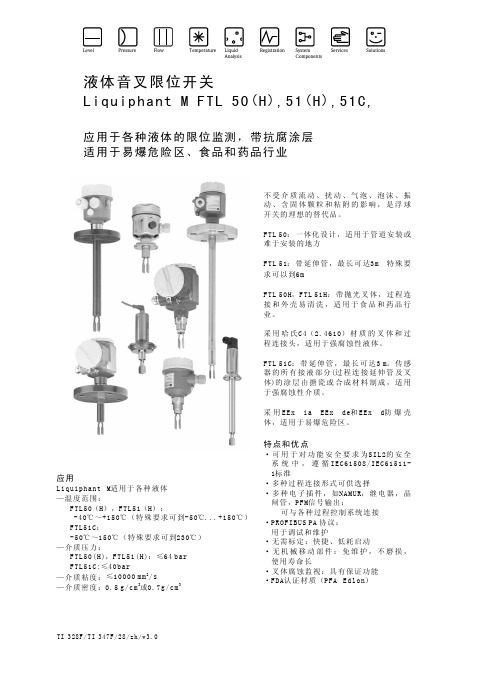

液位开关原理和使用方法一、常见液位开关原理1 浮球液位开关浮球液位开关结构主要基于浮力和静磁场原理设计生产的。
带有磁体的浮球(简称浮球)在被测介质中的位置受浮力作用影响:液位的变化导致磁性浮子位置的变化。
浮球中的磁体和传感器(磁簧开关)作用,产生开关信号。
2音叉液位开关音叉液位开关的工作原理是通过安装在基座上的一对压电晶体使音叉在一定共振频率下振动。
当音叉液位开关的音叉与被测介质相接触时,音叉的频率和振幅将改变,音叉液位开关的这些变化由智能电路来进行检测,处理并将之转换为一个开关信号,达到液位报警或控制的目的。
为了让音叉伸到罐内,通常使用法兰或者带螺纹的工艺接头将音叉开关安装到罐体的侧面或者顶部。
3电容式液位开关电容式液位开关的测量原理是:固体物料的物位高低变化导致探头被覆盖区域大小发生变化,从而导致电容值发生变化。
探头与罐壁(导电材料制成)构成一个电容。
探头处于空气中时,测量到的是一个小数值的初始电容值。
当罐体中有物料注入时,电容值将随探头被物料所覆盖区域面积的增加而相应地增大,开关状态发生变化。
4外测液位开关外测液位开关是一种利用“变频超声波技术”实现的非接触式液位开关,广泛使用于各种液体的液体检测。
其测量探头安装在容器外壁上,属于一种从罐外检测液位的完全非接触检测仪表。
仪表测量探头发射超声波,并检测其在容器壁中的余振信号,当液体漫过探头时,此余振信号的幅值会变小,这个改变被仪表检测到后输出一个开关信号,达到液位报警的目的。
5射频导纳液位开关射频导纳物位控制技术是一种从电容式物位控制技术发展起来的,防挂料、更可靠、更准确、适用性更广的物位控制技术,“射频导纳”中“导纳”的含义为电学中阻抗的倒数,它由阻性成分、容性成分、感性成分综合而成,而“射频”即高频,所以射频导纳技术可以理解为用高频测量导纳。
高频正弦振荡器输出一个稳定的测量信号源,利用电桥原理,以精确测量安装在待测容器中的传感器上的导纳,在直接作用模式下,仪表的输出随物位的升高而增加。
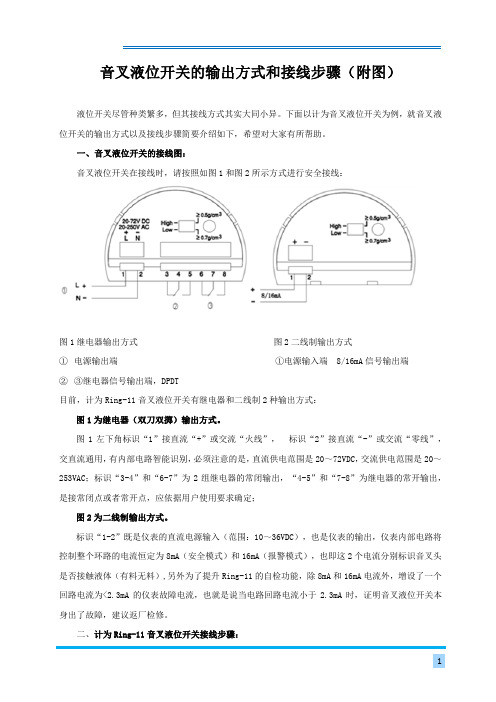
音叉液位开关的输出方式和接线步骤(附图)液位开关尽管种类繁多,但其接线方式其实大同小异。
下面以计为音叉液位开关为例,就音叉液位开关的输出方式以及接线步骤简要介绍如下,希望对大家有所帮助。
一、音叉液位开关的接线图:音叉液位开关在接线时,请按照如图1和图2所示方式进行安全接线:图1继电器输出方式图2二线制输出方式①电源输出端①电源输入端 8/16mA信号输出端②③继电器信号输出端,DPDT目前,计为Ring-11音叉液位开关有继电器和二线制2种输出方式:图1为继电器(双刀双掷)输出方式。
图1左下角标识“1”接直流“+”或交流“火线”,标识“2”接直流“-”或交流“零线”,交直流通用,有内部电路智能识别,必须注意的是,直流供电范围是20~72VDC,交流供电范围是20~253VAC;标识“3-4”和“6-7”为2组继电器的常闭输出,“4-5”和“7-8”为继电器的常开输出,是接常闭点或者常开点,应依据用户使用要求确定;图2为二线制输出方式。
标识“1-2”既是仪表的直流电源输入(范围:10~36VDC),也是仪表的输出,仪表内部电路将控制整个环路的电流恒定为8mA(安全模式)和16mA(报警模式),也即这2个电流分别标识音叉头是否接触液体(有料无料),另外为了提升Ring-11的自检功能,除8mA和16mA电流外,增设了一个回路电流为<2.3mA的仪表故障电流,也就是说当电路回路电流小于2.3mA时,证明音叉液位开关本身出了故障,建议返厂检修。
二、计为Ring-11音叉液位开关接线步骤:对于隔爆型仪表,只有当环境中不存在会引爆的气体或粉尘时才允许打开外盖操作。
请按照如下步骤进行操作:(1)打开外壳盖;(2)松开电缆螺纹接头上的锁紧螺母;(3)去掉连接电缆大约10cm的外皮和芯线末端大约1cm的绝缘层;(4)将电缆穿过电缆螺纹接头插入外壳中;(5)用螺丝刀打开接线端子;(6)按照接线图将芯线末端插入接线端子中;(7)用螺丝刀拧紧接线端子;(8)通过轻拉接入的电缆线来检查接线是否牢靠;(9)拧紧电缆螺纹接头的锁紧螺母,扣紧密封环;(10)拧上外壳盖。
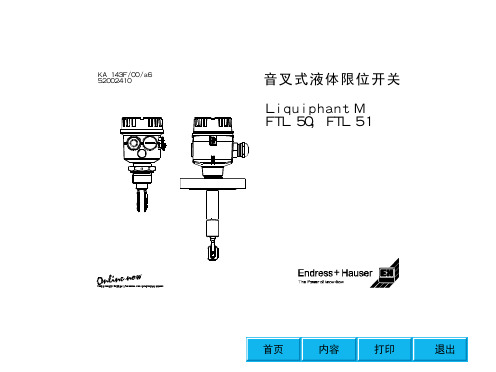

音叉液位开关常见故障及处理办法音叉液位开关常见故障及处理办法在安装与使用音叉料位开关期间,对于专业的仪表人而言,也难免会出现无法解决的专业性问题,此文章会对叉料位开关的常见故障进行详细的讲解,系统分析所在原因以及处理方案。
在此也提醒广大仪表使用者与仪表工程师,当仪表故障出现,采取合适的措施去消除出现的故障现象是一种责任行为。
高质量的音叉料位开关的使用寿命较长,尽管如此,依然可能在运行期间会出现--些故障。
可能存在的故障现象主要出现在电子部件、供电电源、安装位置和振动叉体这几个部位。
当出现故障问题时,首先可以检查输出信号。
在很多情况下,通过输出信号就能够检查到故障原因,并处理相应故障现象。
其他故障分为两大类:在干运行保护或溢流保护时出现错误报告,和指示灯出现红灯闪烁警报。
一、在干运行保护或溢流保护时出现错误报告(1)工作电压是否太低。
请检查、调整工作电压。
(2)电子部件损坏。
请拨动高低位模式开关,当仪表因此而切换时,振动叉体可能会被附着物遮盖或机械性受损。
如果在运行模式正确的情况下开关功能依然有误,请将仪表送去维修。
或者拨动高低位模式开关,如果仪表此后不转换,说明电子部件损坏,请更换电子部件。
(3)安装位置不正确。
请将仪表安装在在容器中不会形成死区或固料失控堆积的位置。
(4)叉体上有附着物。
检查叉体.上是否有附着物,如果发现有附着物,请清除。
(5)高低位模式选择错误。
请重新设置正确的高低位模式(溢流保护,干运行保护)。
二、指示灯出现红灯闪烁报警(1)叉体损坏。
请检查叉体是否受损或被严重腐蚀。
(2)电子部件受损。
请更换电子部件。
(3)仪表其他部件损坏。
请更换仪表或寄回维修。
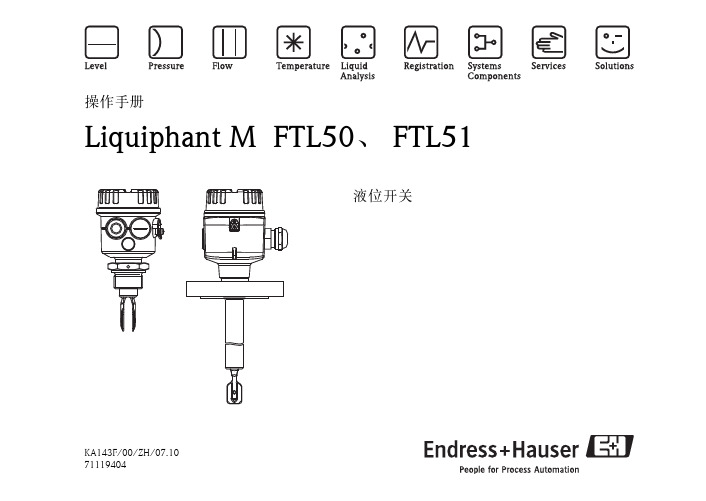
KA143F/00/ZH/07.1071119404操作手册Liquiphant M FTL50、FTL51液位开关目录安全指南4装卸6仪表标识8应用 14测量系统 15安装 19设定 28指示灯信号 32仪表接线 33维护、清洁54技术参数 55附件 57故障检测 61备件 68维修 69补充文档 73 "注意!= 禁止;导致不正确的操作或损坏。
安全指南Liquiphant M FTL50、FTL51为一款液位开关。
使用不当,可能会发生危险。
液位开关Liquiphant M FTL50、FTL51只能由获得授权的合格人员进行安装、连接、调试、操作和保养并应严格按照本操作指南、各种相关标准、法规要求以及适用的认证证书的规定进行。
将电源开关安装在设备周围易于操作的地方。
将电源开关标记为设备的断路器。
B 12B 82C A 2C A 5C A 6C E 2C E 5C E 6C G 2C G 5C G 6C J 2C N 2C N 5C N 6C Q 2C Q 5C Q 6C 12C 82C 85C 86D G 2D N 2D 82F G 2N G 2K A 2K C 2K E 2K E 5K E 6K L 2K P 2J I S B 2220D N 80,P N 100A ,316L (F T L 51)D N 32,P N 6B 1,316L D N 32,P N 6,A l l o y C 4>316L D N 50,P N 6B 1,316L D N 50,P N 6,A l l o y C 4>316L D N 50,P N 25/40B 1,316L D N 50,P N 25/40,A l l o y C 4>316L D N 50,P N 100B 2,316L (F T L 51)D N 80,P N 25/40B 1,316L D N 80,P N 25/40,A l l o y C 4>316L D N 100,P N 10/16B 1,316L D N 100,P N 10/16,A l l o y C 4>316L D N 80,P N 100B 2,316L (F T L 51)D N 50,P N 40C ,316L D N 50,P N 40D ,316L10K 25,R F ,316L 10K 40,R F ,316L D N 25,P N 25/40A ,316L D N 25,P N 25/40B 1,316L D N 25,P N 25/40,A l l o y C 4>316L D N 50,P N 40B 1,316L D N 80,P N 40B 1,316L D N 25,P N 40B 1,316L 10K 50,R F ,316L 10K 50,R F ,A l l o y C 4>316L 10K 80,R F ,316L 10K 100,R F ,316LD N 32,P N 6,A l l o y C 22>316L D N 50,P N 6,A l l o y C 22>316L D N 50,P N 25/40,A l l o y C 22>316L D N 80,P N 25/40,A l l o y C 22>316L D N 100,P N 10/16,A l l o y C 22>316L D N 25,P N 25/40,A l l o y C 22>316L 10K 50,R F ,A l l o y C 22>316L。
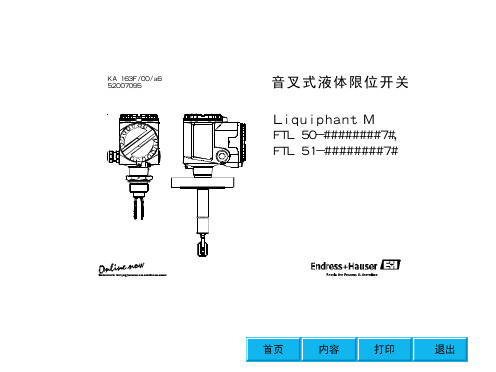
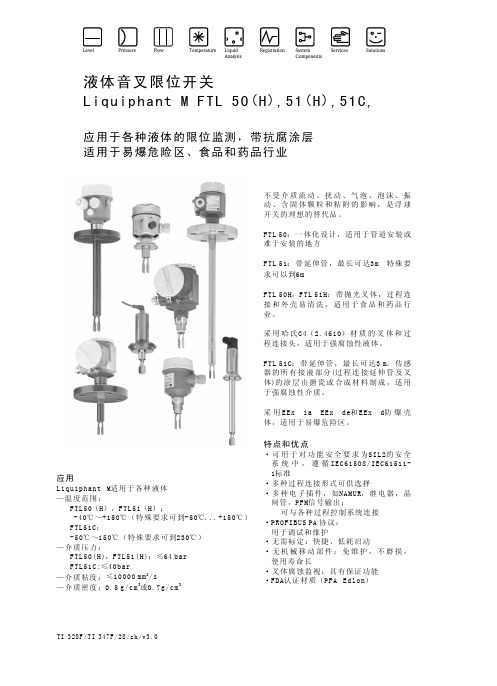
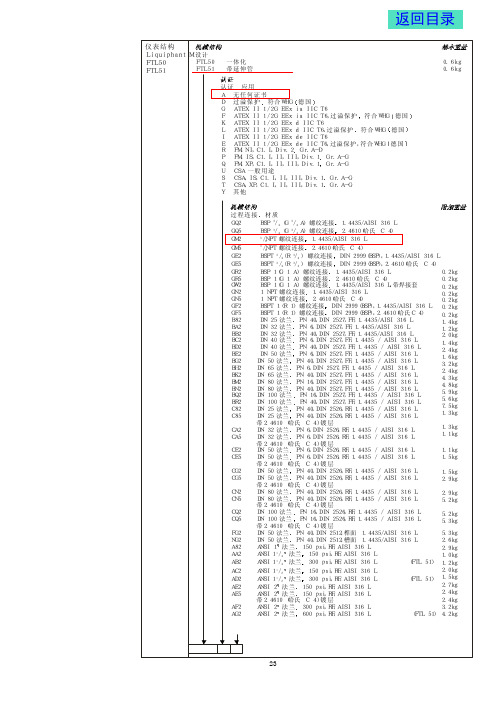
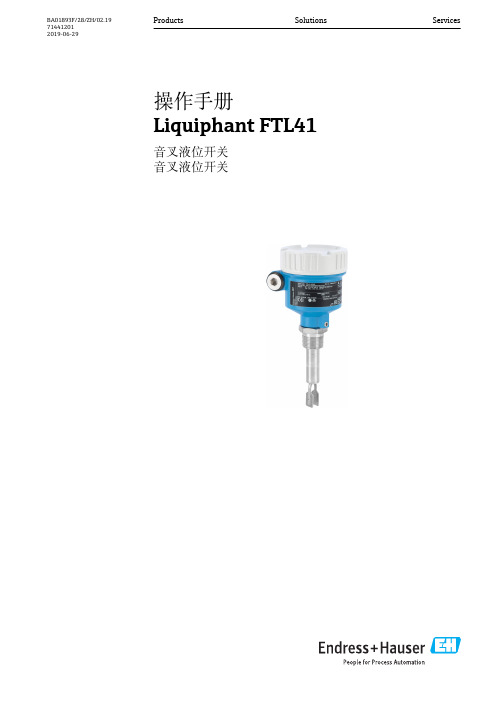
Products Solutions Services操作手册Liquiphant FTL41音叉液位开关音叉液位开关BA01893F/28/ZH/02.19714412012019-06-29Liquiphant FTL412Endress+HauserLiquiphant FTL41目录Endress+Hauser3目录1文档信息 (5)1.1图标 ................................51.1.1安全图标......................51.1.2电气图标......................51.1.3特定信息图标...................51.1.4图中的图标.....................52基本安全指南 (6)2.1人员要求.............................62.2指定用途.............................62.2.1使用错误......................62.3工作场所安全.........................62.4操作安全.............................62.5产品安全.............................73产品描述 (7)3.1产品设计 (7)4到货验收和产品标识 (7)4.1到货验收.............................74.2产品标识.............................84.2.1铭牌 ..........................84.2.2制造商地址.....................84.3储存和运输...........................84.3.1储存条件......................84.3.2运输设备......................85安装 (9)5.1安装条件.............................95.1.1注意开关点.....................95.1.2注意介质粘度的影响.............105.1.3避免黏附.....................115.1.4预留安装间隙..................115.1.5支撑设备.....................125.1.6焊座,带泄露检测孔 ............125.2安装测量设备........................125.2.1所需工具.....................125.2.2安装.........................135.3滑动套管 ...........................145.4安装后检查 (14)6电气连接 (14)6.1连接条件 ...........................146.1.1连接保护性接地端(PE) ........146.2连接测量设备........................156.2.1电子插件FEL42:三线制连接,直流DC-PNP 型..................156.2.2电子插件FEL44:通用电流连接型,带继电器输出..............166.2.3电子插件FEL48:两线制连接,NAMUR 信号(> 2.2 mA/< 1.0 mA)....................196.2.4电缆入口 .....................206.3连接后检查 (21)7操作方式 (21)7.1操作方式概述 ........................217.1.1操作方法 .....................217.1.2电子插件上的部件.. (21)8调试 (21)8.1功能检查............................218.2测量设备上电 (22)9诊断和故障排除 (22)9.1电子插件上的LED 指示灯 (22)10维护 (22)10.1维护任务 (22)10.1.1清洁 (22)11维修 (23)11.1概述...............................2311.1.1维修理念.....................2311.1.2防爆型设备的维修..............2311.2备件...............................2311.3返厂...............................2311.4废弃...............................2312附件 (24)12.1设备专用附件 ........................2412.1.1保护盖,适用金属单腔室外壳......2412.1.2插头.........................2412.2常压滑动套管........................2512.3高压滑动套管........................2613技术参数 (27)13.1输入...............................2713.1.1测量变量 .....................2713.1.2测量范围 .....................2713.2输出...............................2713.2.1输出与输入....................2713.2.2输出信号 .....................2713.2.3防爆连接参数 .................2813.3环境条件............................2913.3.1环境温度范围 .................2913.3.2储存温度 .....................2913.3.3湿度 ........................2913.3.4海拔高度.....................2913.3.5气候等级 .....................2913.3.6防护等级.....................3013.3.7抗振性 .......................3013.3.8抗冲击性.....................30目录Liquiphant FTL4113.3.9机械负载 (30)13.3.10电磁兼容性(EMC) (30)13.4过程条件 (30)13.4.1过程温度范围 (30)13.4.2热冲击 (31)13.4.3过程压力范围 (31)13.4.4测试压力 (31)13.4.5密度 (32)13.4.6密闭压力 (32)13.5其他技术参数 (32)4Endress+HauserLiquiphant FTL41文档信息Endress+Hauser 51文档信息1.1图标1.1.1安全图标危险状况警示图标。
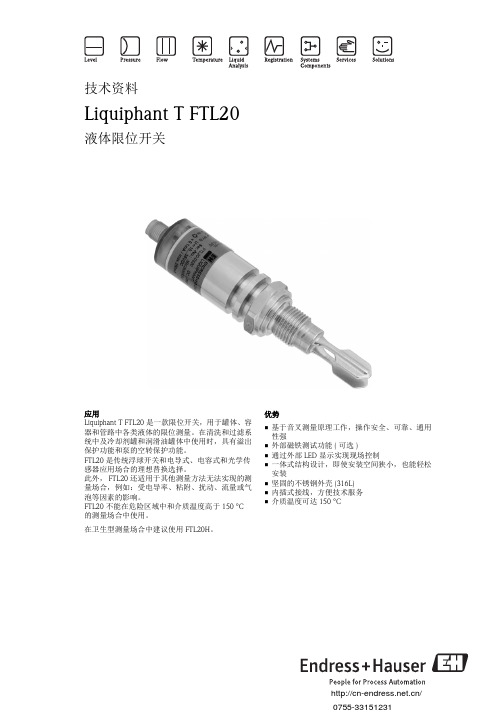
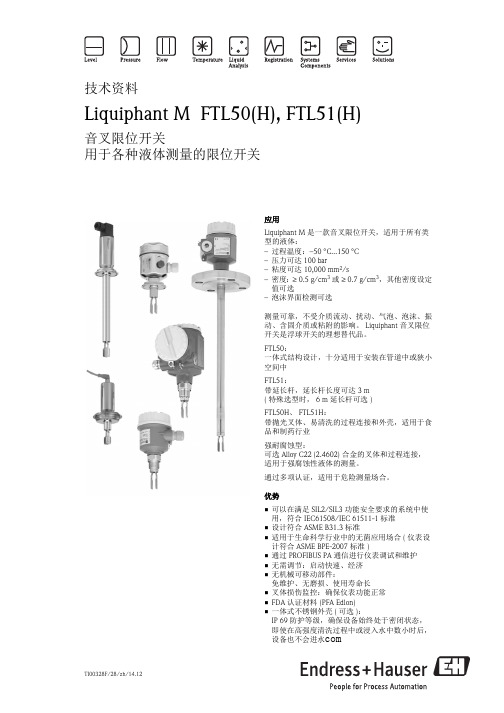
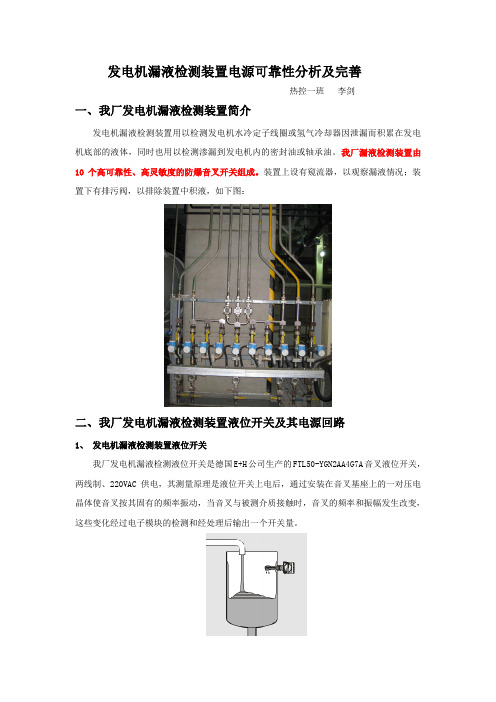
发电机漏液检测装置电源可靠性分析及完善热控一班李剑一、我厂发电机漏液检测装置简介发电机漏液检测装置用以检测发电机水冷定子线圈或氢气冷却器因泄漏而积累在发电机底部的液体,同时也用以检测渗漏到发电机内的密封油或轴承油。
我厂漏液检测装置由10个高可靠性、高灵敏度的防爆音叉开关组成。
装置上设有窥流器,以观察漏液情况;装置下有排污阀,以排除装置中积液,如下图:二、我厂发电机漏液检测装置液位开关及其电源回路1、发电机漏液检测装置液位开关我厂发电机漏液检测液位开关是德国E+H公司生产的FTL50-YGN2AA4G7A音叉液位开关,两线制、220VAC供电,其测量原理是液位开关上电后,通过安装在音叉基座上的一对压电晶体使音叉按其固有的频率振动,当音叉与被测介质接触时,音叉的频率和振幅发生改变,这些变化经过电子模块的检测和经处理后输出一个开关量。
我厂漏液检测装置就地共10个液位开关,具体如下:2、 发电机漏液检测装置电源回路基建出厂设计,我厂发电机漏液检测装置10个音叉液位开关的电源由热控交流电源柜一路220VAC 送至就地发电机漏液检测装置柜,再并联到10个小空开,分别为各音叉液位开关供电,如下图所示:3、漏液检测装置电源回路存在的隐患就地的E+H FTL50-YGN2AA4G7A音叉液位开关,使用常开触点,经试验当发电机漏液液位真高或音叉开关电源丢失时,开关闭合。
目前10个发电机漏液液位检测开关公用一路电源(热控交流电源柜50CUJ01-13K),当机组正常运行期间,若电缆损坏或热控交流电源柜误碰空开,导致电源丢失时,就地音叉开关会闭合,开关信号误发,特别是出线盒隔离板上液位高高和出线盒底部液位高高两项ETS 保护误发,导致机组跳闸,为机组的安全稳定运行带来较大隐患。
三、我厂发电机漏液检测装置电源完善措施1、措施制定针对发现的以上隐患,热控领导及相关技术人员及时提出如下整改和完善措施:即将就地发电机漏液液位检测音叉开关分为四组:作ETS保护的6个音叉开关两两交叉分为3组,4个报警用的音叉开关为一组。

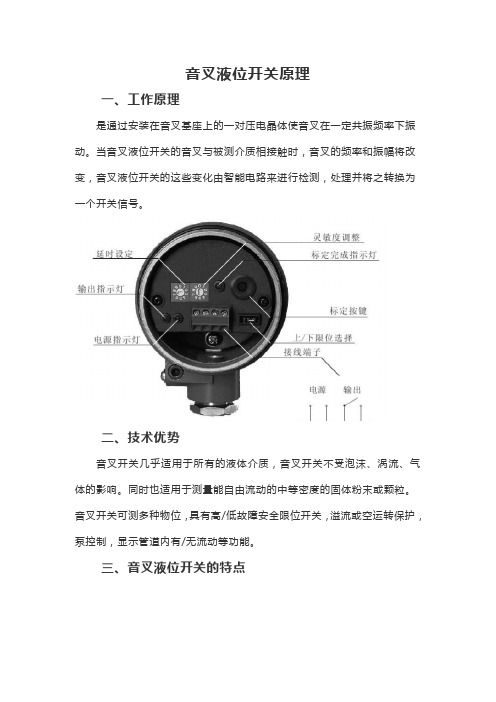
音叉液位开关原理
一、工作原理
是通过安装在音叉基座上的一对压电晶体使音叉在一定共振频率下振动。
当音叉液位开关的音叉与被测介质相接触时,音叉的频率和振幅将改变,音叉液位开关的这些变化由智能电路来进行检测,处理并将之转换为一个开关信号。
二、技术优势
音叉开关几乎适用于所有的液体介质,音叉开关不受泡沫、涡流、气体的影响。
同时也适用于测量能自由流动的中等密度的固体粉末或颗粒。
音叉开关可测多种物位,具有高/低故障安全限位开关,溢流或空运转保护,泵控制,显示管道内有/无流动等功能。
三、音叉液位开关的特点
1、适应性强:被测物料不同的电参数、密度对测量均不产生影响。
结垢、搅动、湍流、气泡、振动、中等粘度、高温、高压等恶劣条件对检测也无影响。
2、免于维护:由于音叉限位开关的检测过程由电子电路完成,无活动部件,所以一经安装投运便不需要维护。
3、不需调校:由于音叉限位开关的检测不受被测介质电参数及密度的影响,所以无论测量何种液体都不需现场调校
4、标准抛光电极
5、通过高频激励,实现优异的抗噪声干扰能力
6、开关的工作与介质的导电率、介电常数、粘度、压力及温度无关。
7、不同探头长度可适应各种密度的介质。